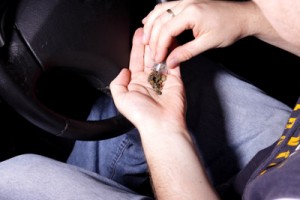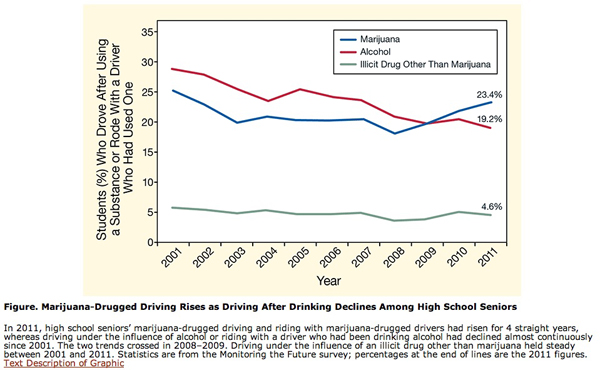A new review of teen survey responses to the annual Monitoring the Future survey provides urgent reasons that parents should pay very close attention to their children’s drug or alcohol use. A recent report published by the National Institute on Drug Abuse reveals how many teens say they drink and drive or smoke pot and then drive. This review shows that some of these numbers have been falling, others have been climbing steeply in the last several years.
Overall, the number of high school seniors who drove after drinking have been falling, dropping from their high of 16% in 2008 to 8.7% in 2011.
But in 2008/2009, this dropping line crossed the ascending line representing those who drove after smoking marijuana. That number increased from 10.4% in 2008 to 12.4% in the 2011 survey.
The same line-crossing occurred in the graph of those who either drove after smoking or drinking or got in a car with a driver who had been doing so. This graph shows the rates of driving or being driven after alcohol, marijuana or other illicit drug were used by the driver.
The kind of impairment resulting from drinking is pretty well known but many marijuana users think they can still drive safely. The National Highway Transportation Safety Administration (NHTSA) doesn’t agree.
In their official evaluation of the effects of cannabis use on driving performance, they note “Marijuana has been shown to impair performance on driving simulator tasks and on open and closed driving courses for up to approximately 3 hours.”
They note the following problems in the drug user’s ability to handle the car and conditions of the road:
• Decreased car handling performance
• Longer reaction times
• Impaired time and distance estimation
• Tendency for inappropriate movement to the left or right
• Sleepiness
• Poor physical coordination
• Longer time to make decisions and determine appropriate responses.
Marijuana smokers may feel they can “pull themselves together” so they can drive. About this, the NHTSA says: “Some drivers may actually be able to improve performance for brief periods by overcompensating for self-perceived impairment. The greater the demands placed on the driver, however, the more critical the likely impairment.”
One of the most important observations they made in their review was this:
“Mixing alcohol and marijuana may dramatically produce effects greater than either drug on its own.”
The impairments observed by the NHTSA were validated by other findings in the NIDA report. Among the students who drove after drinking or using marijuana, the number who received tickets or warnings or who had traffic accidents were much higher.
Accidents:
Not using alcohol or marijuana – 16.3%
Using marijuana then driving – 26.9%
Drinking then driving – 30.2%
Tickets or warnings:
Not using alcohol or marijuana – 20.2%
Using marijuana then driving – 42.1%
Drinking then driving – 43.2%
These numbers all add up to very good reasons you should know for sure if your high-school-aged child is drinking or smoking marijuana. His or her life may actually be at stake.
http://www.drugabuse.gov/news-events/nida-notes/2014/07/among-high-school-seniors-driving-after-marijuana-use-surpasses-drunk-driving
http://www.nhtsa.gov/people/injury/research/job185drugs/cannabis.htm

